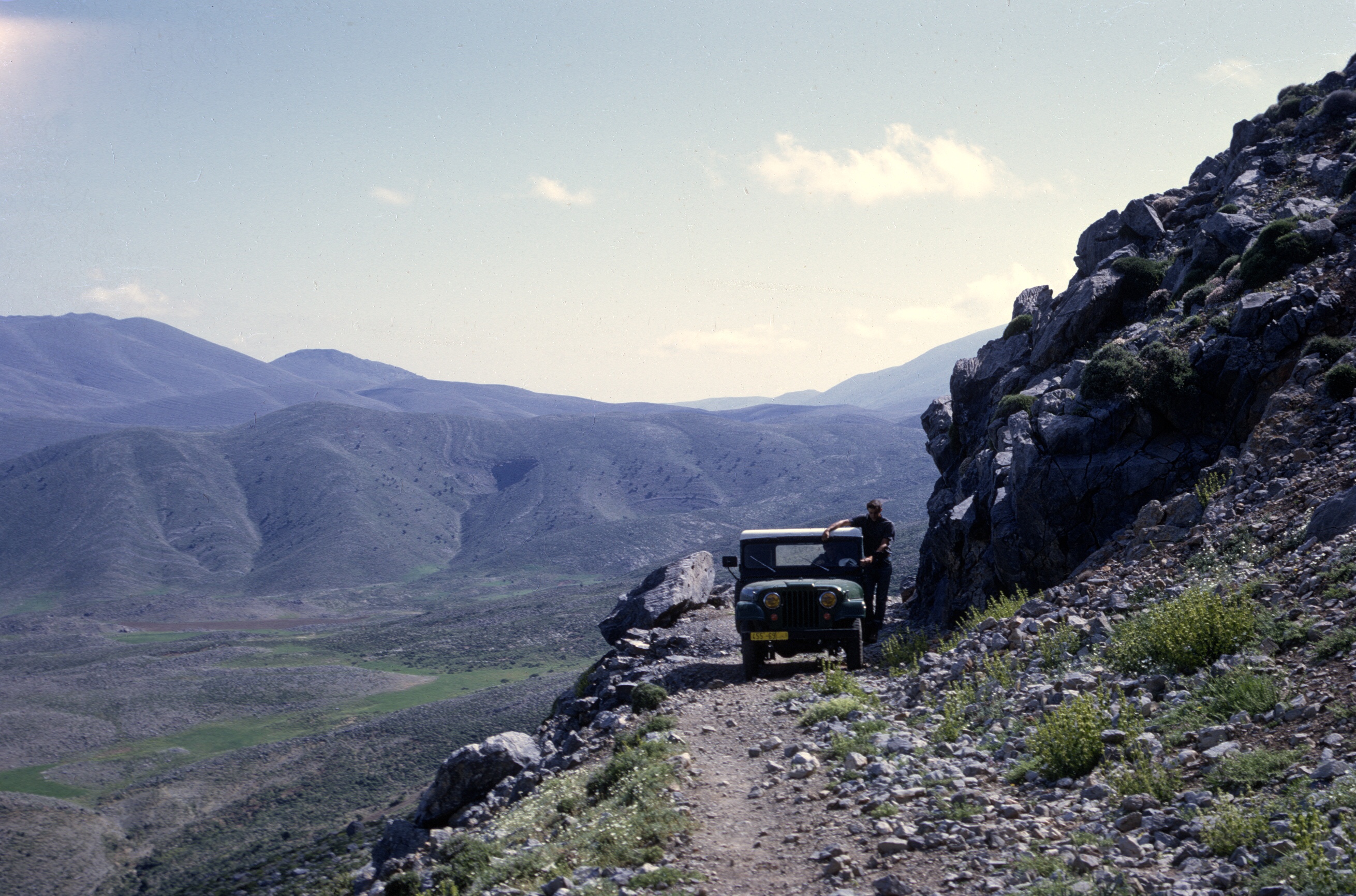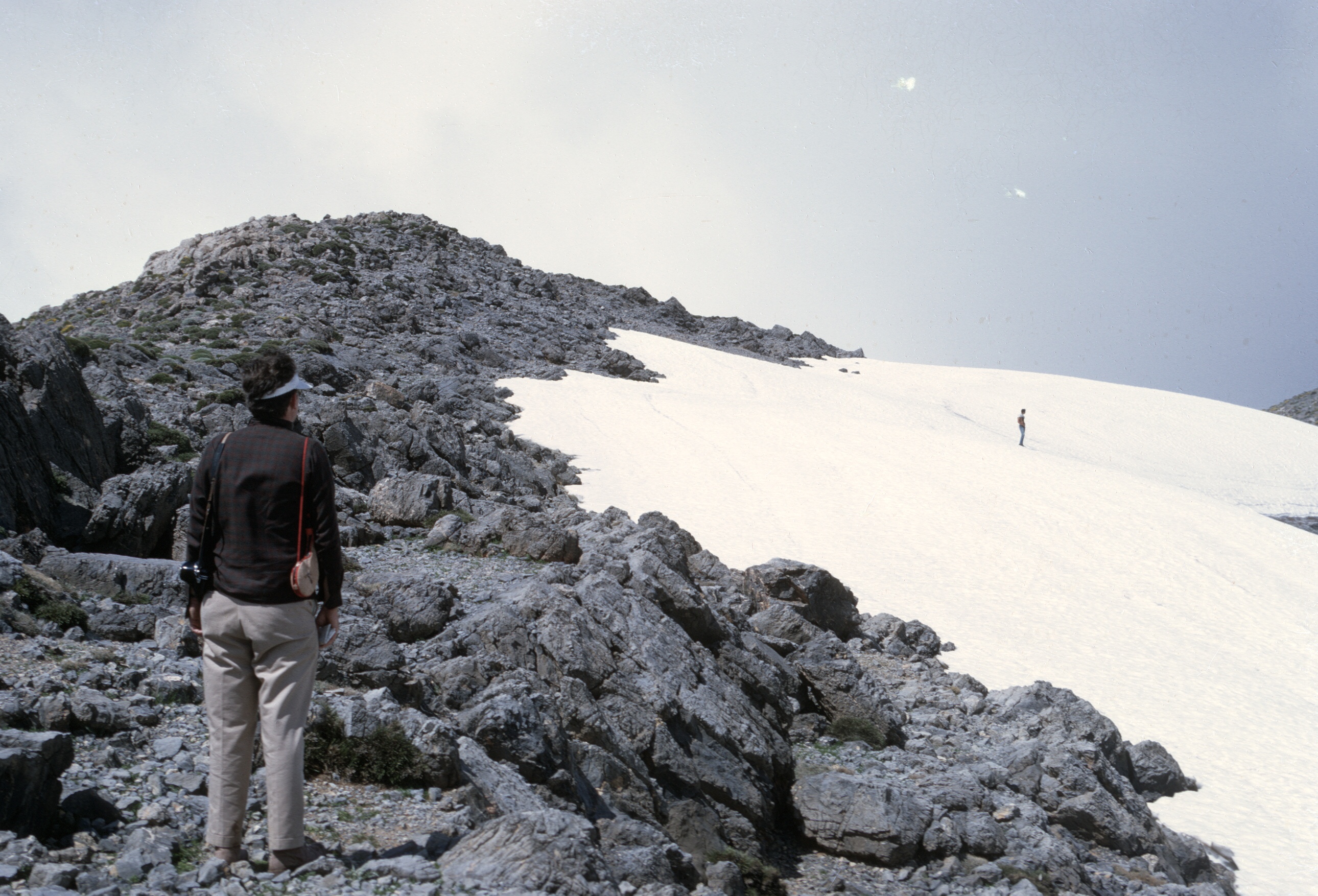جبل بويبلان

In the nineteen sixties, there was no paved road to the foot of Bouiblane. Today there may be one, at least part way, and perhaps the slopes have been developed for skiing. I believe that the French, during the Protectorate, skied there. In 1968, the way in, whether you came from Sefrou or Taza, was by mountain tracks. Streams flooded the pistes, rockfalls blocked them, and in the cold months, snow on them increased the danger of slipping off the road, and potentially down some very steep slopes.
Travelling from Oujda to Taza, Bouiblane is visible from the plains of the lower Moulouya, and, of course, from the air.

Bouiblane also is visible from the region of Fes. The mountain was visible from my rooftop in Sefrou. It was my Kanchenjunga, and Sefrou, perhaps, my Darjeeling. Not the ominous looming presence of Kanchenjunga of the nuns of Black Narcissus, but a friendly, steady presence. The mountain beckoned. It was impossible to resist the temptation to see it up close. Ahermoumou offered a belvedere and a grand view, but at the price of a drive.

Climbing the stairs to the roof of my house was far easier. In the twilight on clear winter days, Bouiblane slopes slowly turned pink, as the kestrels living in the city wall did a few more acrobatics before disappearing into their holes for the night.

Strictly speaking I was not supposed to use it for tourism. And I was very good about that generally speaking. I used buses and taxis to go back and forth to my job in the Ministry of Agriculture in Fes, for example. The jeep would have made the commute much shorter and more convenient, but most of the time I read and enjoyed the commute. In restrospect, though, I wish I had used the jeep much more for touring my corner of Morocco. I never went to Erfoud and Merzouga to see the dunes, though I saw plenty crossing the Algerian Sahara after leaving the Peace Corps.
Gaylord and I set off with no good plan in mind. I think we knew that there was a forestry station or an old ski chalet at Taffert. It was probably mentioned in the Guide Bleu. We took some food and sleeping bags in any case, and made pretty good progress until the last 15 or 20 kilometers, where we began to encounter snow on the road. The jeep had off the road tires. They were not much good on snow. Coming around a long, deep curve, the jeep began to slide toward the edge of the road where there was nothing but a steep slope. Luckily I recovered control. From that point, we slowed down considerably. We also began to wonder how we would get back if it snowed overnight. We didn’t have a weather forecast, but the skies were clear, and, foolishly optimistic, we continued. It certainly would have been embarrassing to get stuck there.
Not long after the slipping and sliding incident, the road leveled out and paralleled the mountain crest. We picked up a local man and he rode all the way to Taffert, where, after thanking us, he wrapped his sandaled feet in rags, and made straight up the mountain toward the pass at the western end of Bouiblane, referred to as Tizi Bouzabel. A dirt road goes through it, and I imagine that once he was over the pass there was less snow and the going got easier. The sun was setting and it was getting colder, so we wished him well and he wasted no time. He was up and over before the sun set.

There was a guardian at Taffert, but the building, though substantial, was dilapidated, and there was no fire to temper the cold. I reckon it wasn’t used much at the time. I don’t recall electricity either.

So we ate and went to sleep in our sleeping bags.
The next morning was grey and overcast, and the mountain, covered with snow, looked a bit menacing. We were still worried about the road conditions, so we left early and returned home. There were no problems but we drove cautiously.
The next trip was with Louden and his wife, Ginny, and their dog, Pigpen. We didn’t get very far past Ahermoumou.

The track was muddy and snowy, and the streams, with enough water to flow over the crossings, had to be forded. I think we gave up when faced by more serious snow. Pigpen loved the trip, a real change of pace from his yard in Rabat.

That trip set the stage for the next. Don Brown, then an administrator, and formerly a Peace Corps volunteer in Oujda, had always wanted to climb Bouiblane, which he had frequently seen on trips back and forth to Oujda. Now we had a newer Jeep. Louden was there, along with a volunteer, John Paulas. Gaylord and I filled out the roster. It was spring and we started out very early.

There was no problem getting to Taffert aside from some fallen rocks.

 I don’t remember whether we went on our hikes immediately.
I don’t remember whether we went on our hikes immediately.

I think Don, Louden, Gaylord, and John were set on getting to the summit of Moussa ou Salah. For whatever reason, I think it was weather, I decided that a shorter hike made more sense. I think I suspected that there wasn’t enough time. I climbed the little pinnacle to the left of the Tizi Bouzabel, directly above the refuge at Taffert, and was rewarded with some great views.


The others soon found out the obvious, that the crest of Bouiblane was a very long slog, and only took them to the saddle between Bouiblane and Moussa ou Salah.





From that point, they could see clearly that the summit of Moussa ou Salah was higher, but it was very late and they were tired, so they returned defeated. The next day it was foggy at Taffert so we returned home via the Sefrou track.

This set the stage for two more attempts, both via the Taza track. Louden and John returned. Maybe Louden will elaborate if he reads this post, but I think he or John told me that that they went up in moonlight. It is only about a three or four hour climb, so perhaps they witnessed a sunrise, which would have been awesome. It’s always great to be on a big mountain at sunrise and sunset. In the Alps, this is often the plan as you want to be down and out of range of the rocks that hurdle down the snowfields in the warming sun of the afternoon. If you ever experience the sound that these projectiles make, you will never forget it.
Maine people await the first sunrise in the Lower 48 from Cadillac Mountain or, much more rarely, Mount Katahdin. I witnessed a sunset from Toubkal, but paid for it, descending through a damp and cold mist.

I also saw a sunset descending the west ridge of Angour, and another from the summit of Tichoukt. One of my favorite sunsets, though, was from the summit of Pic du Midi de Bigorre, which resulted in a long, long moonlit walk down to a ski place in La Mongie. My companion and I were lucky it was a warm night, and the receptionist was surprised that we arrived at the nearly deserted ski resort without a car! We tried hitching, but very few cars were crossing the Col du Tourmalet that night, and none of them was interested in picking up hitchhikers in the dark.

In May of 1970 I finally got my chance at Moussa ou Salah, when a group of staff and volunteers took a couple of jeeps in from Taza.

The views from the drive to the base of the mountain were often beautiful.



We camped overnight and climbed the next morning. The views from the summit of Moussa ou Salah were nothing special. There was a cairn on the summit. Was it a burial spot for a local holy man?


I think John Paulas and some Peace Corps trainees later climbed Bou Naceur, visible from the summit of Moussa ou Salah, probably in the summer. That must have been a long, hot and dry ascent. There is not a lot of water on any of Morocco’s mountains in the summer.
Morocco is such a beautiful country!



Merci beaucoup pour avoir relaté la géographie de ma région. À cette époque j’étais encore young
Le sam. 4 nov. 2017 à 04:04, Morocco That Was a écrit :
> Dave posted: “جبل بويبلان In the nineteen sixties, there was no paved road > to the foot of Bouiblane. Today there may be one, at least part way, and > perhaps the slopes have been developed for skiing. I believe that the > French, during the Protectorate, skied there. In” >
LikeLike
It was amazing. verybeautiful photos love that mountain peaks. covredwith snow. very bewitching views. thank you so much for sharing. i will put this place in my travel list. wish to visit some day. keep sharing. stay in touch. happy blogging
LikeLike
On a dit que le voyage forme la jeunesse. C’est qui est certain, c’est qu’un long séjour à l’étranger, quand on n’a que 22 ans, ne cesse jamais d’apporter quelque chose de nouveau à une vie. J’ai été chanceux d’en passer le mien au Maroc.
LikeLike